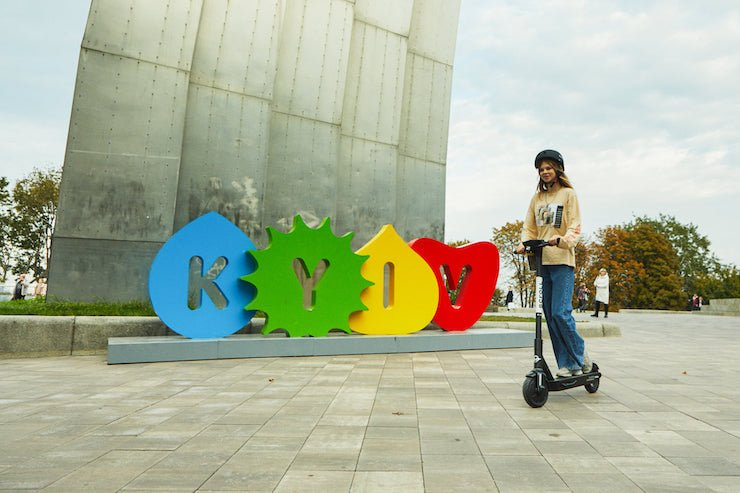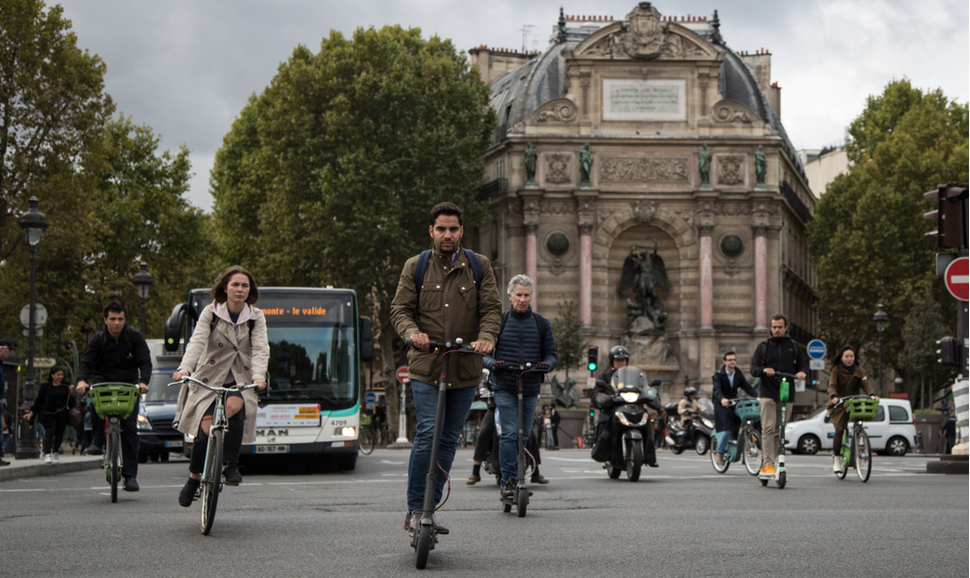

Since 2017 the cities of the USA, Asia and Europe have been swept through by the avalanche-like wave of light personal transport. Various electrified vehicles for 1 person such as electric bicycles, electric scooters, unicycles, gyro scooters went on mass sale and hire. Ukrainians are trying to keep up with the rest of the world. And while some are buying or renting mini-vehicles, entrepreneurs are trying to launch the rental of transport gadgets in Ukrainian cities. Are Ukrainians eventually ready for the micromobility boom?


Are the Ukrainian cities ready to face the micromobility?
Apparently, it's the phenomenon that sharply broke in and gained a foothold in hundreds of cities around the world. It has diverse but meaningful names in particular: "micromobility", "micro transport", "personal(electric) transport".
The Western world generalizes and frequently uses the notion of "micromobility" meaning a way of commuting by a light personal vehicle with at least 1 wheel.
Types of microtransport can be divided into 3 main categories by energy source, which drive the vehicle due to:
In case of the electric power and internal combustion engines motors of small (micro) size are obviously used. Micromotors from other energy sources can potentially arise and be put into series production.
Nowadays, micromobility includes electric scooters (e-scooters), bicycles and electric bicycles, skateboards, unicycles, gyroscooters, segways, etc. Some of the stated above kinds of movement can develop speeds of up to 20-25 km\h and to 80 km\h. Typically, the weight and the size of personal light transport does not exceed human parameters.
Economic opportunities, inflow of population to cities, demographic change, technological progress, service development, eco and electrification trends and the growth of congestion due to poor urban transport management are pushing entrepreneurs and users to seek alternative ways to commute.
Active people who value their time and need to move in an urban environment, instead of wasting hours of precious time in traffic jams increasingly give their preference to small individual vehicles. Residents of the cities of the USA, Europe and Asia would foremost consider (now especially popular) electric scooters as an "access" kind of transport. They also call it "first / last mile transport". In practice, this is the distance from home to the office or the mall (and vice versa) that a person overcomes with previous types of transportation, such as parked cars or public transport. This allows the commuters to move through traffic jams much faster, saving personal space and helping to distance from other people.
In order to figure out if any Ukrainian city or town is ready for the active use and development of micromobility, it is necessary to clarify:
International experience shows that users of electric scooters and other means of light personal transport are equated with the rights and responsibilities of cyclists. The process of the legitimation of micromobility users in Ukraine began in December 2019. The public expert community submitted its proposals to the deputies of the Verkhovna Rada of Ukraine from the Committee on Transport and Infrastructure. So far, two bills have been registered of varying quality preparation for the settlement of the issue, but as of May 2020 no normative acts have been considered. Therefore, we still do not have the law. Due to these circumstances the users do not know what their rights and responsibilities are and therefore they are not aware of the space where they can ride., What's more, in case of an accident the police do not know how to cфеупщкшяу a driver of a scooter, monocycle, gyro etc. Overseas experience shows that the most successful solution was to force all users of the means of micromobility to use cycling infrastructure. To a huge regret, Ukrainian actuality faces the potential users with the harsh realities of the insufficient or lack of cycling infrastructure. It is also recommended to forbid high-speed vehicles to drive on sidewalks to avoid pedestrian injuries. The prolonged correspondence with the city councils eventually yielded the results. So the outcomes are represented below. To our service the data on the existing cycling infrastructure of cities and regional centers of Ukraine as of April 2020 which has been collected for the first time in Ukraine.
The infographics represent the leaders and outsiders only on 1 criterion which is the general official length of bicycle paths and bicycle lanes in the cities. The inaccuracy to compare the same number of km of cycling infrastructure in different size cities to assess the comfort or sufficiency of the cycling network is also obvious.
For example, Kyiv possesses the official 91.5 km of bike paths which cover an area of 839 thousand square km, while Ivano-Frankivsk has 17.5 km of bike paths and a total city area of 83,700 thousand km. This shows that the capital loses in favor of the smaller city due to additional criteria including higher road density for cyclists.
Taking into account: a) the total length of cycle paths / lanes; b) population; c) the area of the city; d) the length of the road network, TOP-5 cities of Ukraine with existing (although currently not enough) cycling infrastructure is as follows:
Each of the above and the rest of the country's cities need to increase the total length of cycling infrastructure as a basic element for the movement of all types of micro mobility. It is worth noting that on the streets and roads of Ukrainian cities the municipal authorities and the police do not work effectively on traffic safety. As a result, thousands of people die and are injured every year. There have been only a few electric scooter rental services that have started operating in Ukraine in a limited test mode recently and have gained interest of businessmen and potential users worldwide. I believe that considering lack of integral cycling infrastructure and rental electric scooter services might save a certain number of lives. The vast majority of Ukrainian cities have to change their approaches to street planning and reconstruction. So that the interests of all categories of road users will be taken into consideration in the urban space and the speed and flow of traffic are regulated by the engineering solutions.
Some people may not like or accept bicycles or other types of light personal transport, but the growth of such users is objectively constant. Even though Ukraine is significantly leaning behind European countries concerning issues of micromobility in general it must be taken into account.
Here's the objective data concerning the issues stated about above:
The NGO Cyclists' Association of Kyiv monitors the activity of cyclists in the city. According to the latest count in April 2020 showed that the number of cyclists in Kyiv has increased more than 2.5 times in comparison with the spring of 2019.
Data from Google Trends.
Blue is a bicycle; red – electric bicycle; yellow – electric scooter; green – gyroboards and gyro scooters
According to the data the demand for electric scooters increased by 188% in May 2020 in contrast to May of 2019. As for bicycles it grew by 182% over the same period.
In case of an increase of heavy traffic on the city streets, light personal transport will be both in demand and will require the attention of city leaders and efforts to create the appropriate infrastructure. After all, the rhetoric of some car drivers should change to interest instead of aggression against cyclists and scooter riders. Consequently, it can be beneficial for the drivers. The more cycling infrastructure is provided the more people will switch from cars to cycling. The fewer cars and less traffic jams will those interested drivers experience every day .
Conclusion
We are witnessing changes and transformations in urban world trends. The municipalities of many cities have been able to create both temporary and permanent cycling infrastructure and widen the sidewalks in both hemispheres of the planet for weeks and months during the pandemic. Unfortunately, as long as our city officials do not use the experience of other continents to simplify the bureaucratic hurdles. They also demonstrate a weak understanding of the benefits of light personal transport and therefore don't make quick and efficient decisions. Illegitimate micromobility users are currently forced to get on unicycles, scooters or other similar vehicles being often afraid for their own safety to jump into a pit, a downpour or get under the wheels of a car. That is why they move on the sidewalks where they endanger adults and small pedestrians. Objectively speaking, Ukrainian cities are extremely poorly prepared to provide and regulate the safe movement of personal light transport. However, in case of intensification of solving this current issue by local governments and parliamentarians, in a few years they will create adequate and favorable conditions for the prosperous development of urban micro-mobility. (the emergence of secure infrastructure and reduced speeds in cities).
Повномасштабне вторгнення спричинило руйнування й втрати, ускладнило розвиток і планування майбутнього. Проте економічне зростання –… Читати більше
“Рубрика” зібрала для вас статті, які, як, власне, і березень, кажуть: навіть у найскладніші часи… Читати більше
Першим кроком до того, щоб розпоряджатись своїми коштами грамотно, є планування бюджету. Як розрахувати кошти… Читати більше
Discover practical advice for parents of teens with ASD. Learn how to support your child… Читати більше
Вже під час війни Україна використовує штучний інтелект (ШІ) як потужний інструмент для відбудови та… Читати більше
У Житомирській обласній філармонії ім. С. Ріхтера пів року працює студія PНIL-ART. Тут професійні артисти… Читати більше
Цей сайт використовує Cookies.